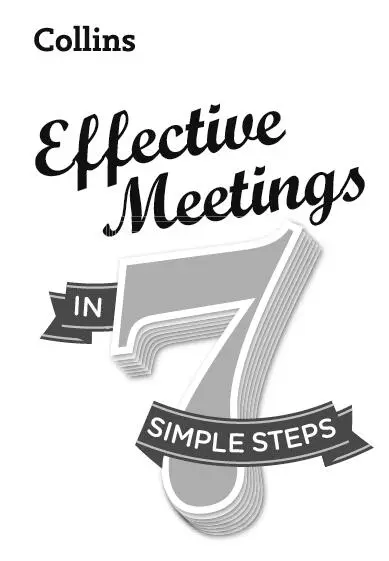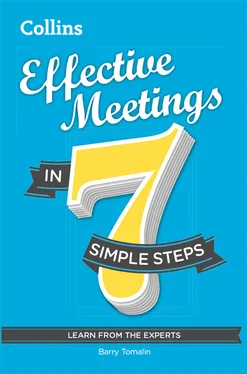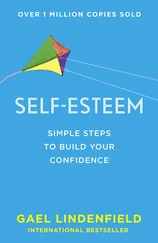
Step 1:Organise people, places and times Step 1 ORGANISE PEOPLE, PLACES AND TIMES ‘Did we make a decision in there?’ —US executive after a meeting in the UK
Step 2:Prepare useful documents Step 2 PREPARE USEFUL DOCUMENTS ‘Whoever controls the minutes, controls the meeting!’ — UK finance manager
Step 3:Participate with impact Конец ознакомительного фрагмента. Текст предоставлен ООО «ЛитРес». Прочитайте эту книгу целиком, купив полную легальную версию на ЛитРес. Безопасно оплатить книгу можно банковской картой Visa, MasterCard, Maestro, со счета мобильного телефона, с платежного терминала, в салоне МТС или Связной, через PayPal, WebMoney, Яндекс.Деньги, QIWI Кошелек, бонусными картами или другим удобным Вам способом.
Step 4:Host virtual meetings Конец ознакомительного фрагмента. Текст предоставлен ООО «ЛитРес». Прочитайте эту книгу целиком, купив полную легальную версию на ЛитРес. Безопасно оплатить книгу можно банковской картой Visa, MasterCard, Maestro, со счета мобильного телефона, с платежного терминала, в салоне МТС или Связной, через PayPal, WebMoney, Яндекс.Деньги, QIWI Кошелек, бонусными картами или другим удобным Вам способом.
Step 5:Use informal meetings wisely Конец ознакомительного фрагмента. Текст предоставлен ООО «ЛитРес». Прочитайте эту книгу целиком, купив полную легальную версию на ЛитРес. Безопасно оплатить книгу можно банковской картой Visa, MasterCard, Maestro, со счета мобильного телефона, с платежного терминала, в салоне МТС или Связной, через PayPal, WebMoney, Яндекс.Деньги, QIWI Кошелек, бонусными картами или другим удобным Вам способом.
Step 6:Adapt to meeting dynamics Конец ознакомительного фрагмента. Текст предоставлен ООО «ЛитРес». Прочитайте эту книгу целиком, купив полную легальную версию на ЛитРес. Безопасно оплатить книгу можно банковской картой Visa, MasterCard, Maestro, со счета мобильного телефона, с платежного терминала, в салоне МТС или Связной, через PayPal, WebMoney, Яндекс.Деньги, QIWI Кошелек, бонусными картами или другим удобным Вам способом.
Step 7:Run efficient, effective meetings Конец ознакомительного фрагмента. Текст предоставлен ООО «ЛитРес». Прочитайте эту книгу целиком, купив полную легальную версию на ЛитРес. Безопасно оплатить книгу можно банковской картой Visa, MasterCard, Maestro, со счета мобильного телефона, с платежного терминала, в салоне МТС или Связной, через PayPal, WebMoney, Яндекс.Деньги, QIWI Кошелек, бонусными картами или другим удобным Вам способом.
Keep Reading Конец ознакомительного фрагмента. Текст предоставлен ООО «ЛитРес». Прочитайте эту книгу целиком, купив полную легальную версию на ЛитРес. Безопасно оплатить книгу можно банковской картой Visa, MasterCard, Maestro, со счета мобильного телефона, с платежного терминала, в салоне МТС или Связной, через PayPal, WebMoney, Яндекс.Деньги, QIWI Кошелек, бонусными картами или другим удобным Вам способом.
About the Author
Copyright
About the Publisher
Step 1
ORGANISE PEOPLE, PLACES AND TIMES
‘Did we make a decision in there?’ —US executive after a meeting in the UK
Be clear why the meeting is necessary.
Only relevant people should attend the meeting.
Book meeting rooms and facilities early.
Keep to an agreed date and time.
Send regular reminders to delegates.
Be unclear about the purpose of the meeting.
Don’t check and chase up attendance.
Don’t check layout and organisation of the meeting room.
Don’t send out invitations.
Ignore the paperwork (agenda, minutes).
Welcome to the world of meetings. This is the activity which will take up the majority of your time at work. Up to 60 per cent, in fact. An estimated four million hours are spent in meetings every day in the UK alone.
So now you’ve realised this is likely to be your major work activity you need to know how to organise your time. The best way to do this is to use the time-honoured framework of five W’ s and an H: Why, What, Who, When, Where and How. Let’s start with Why .
Why so many meetings? Good question. Meetings are like tribal gatherings. Work groups share a practical and emotional need to get together and discuss things and to exchange information.
You may not have much choice about which meetings you attend, but even meetings you think are irrelevant may be useful. You get the opportunity to observe how meetings work. Remember, don’t just focus on the topic, focus on the mechanics of the meeting (how it’s constructed and run) as well.
Meetings are the lifeblood of any organisation. They are the way information is shared in the group. They are the prime way of giving the work group a sense of belonging. This is why it’s worth:
limiting the number of meetings
having more focused meetings
having shorter meetings.
Let’s unpack each item on that list.
Limit the number of meetings
Attend four two-hour meetings back to back and you’ll know why you need to limit the number of meetings. Your whole working day has gone – and you haven’t done any desk work yet. So you’re already behind. In addition, by the end of the fourth meeting, what you discussed in the first meeting is a distant memory.
If you’re lucky enough to be able to choose which meetings to attend, consider these criteria. Prioritise meetings which:
directly concern you
have information you need to know about
cover responsibilities you have to report on
Читать дальше













